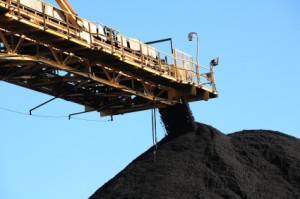 Energy is one of the most vital concerns for any person looking to reduce dependence on the government and other outside sources. An overwhelming majority of homes are hooked up to municipal grids for electricity, water and sewage, and consumers pay accordingly for the use of these services.
Energy is one of the most vital concerns for any person looking to reduce dependence on the government and other outside sources. An overwhelming majority of homes are hooked up to municipal grids for electricity, water and sewage, and consumers pay accordingly for the use of these services.
Coal-fired power plants are a primary source of electrical power for U.S. homes and businesses. Coal-fired plants account for roughly 50% of all power generated in the U.S. As such, coal stockpiles and prices directly affect utility bills. An additional consideration is the import and export of this versatile resource.
The United States has some of the largest coal reserves on the planet, and it is the second leading exporter of coal. As China and India push for industrialization and modernization, and their power needs grow, they are building more coal-fired power plants to handle their increased requirements. China has vast coal reserves, but its coal production is declining and they are importing greater amounts of coal. India does not have such vast reserves, and accounts for a large share of coal imports as well.
China’s demand for power increased from 315 to 900 gigawatts over the past ten years. As demand has grown, additional power plants have been constructed and brought online. Coal-fueled power plants now provide 78% of the country’s power. China currently uses roughly three times the amount of coal that the U.S. uses, and imported 150 million tons this year. Power production in the country is expected to double within the next eight years, which will double their coal imports. When that new amount doubles again in the future, it will exceed the world’s total export production. This does not factor in any further demand from India or other developing countries.
Previously, much of these countries’ requirements for coal were handled by Australian and Indonesian imports. Recent natural disasters have greatly reduced their capacity to meet demand, and China and India have been purchasing from other countries, including the U.S. Additionally, countries such as South Africa, which normally supply Europe’s coal needs, are shipping to India and China. To compensate, European countries are purchasing greater amounts of coal from the U.S. As Asian countries generally purchase from Australia and Indonesia to reduce shipping costs, South Pacific disasters have improved the market share for U.S. companies.
China presents the most troubling issue. Their electricity requirements have doubled over the past decade, as have their coal imports. With the Australian crisis, this has placed an increased demand on American supplies. As the demand increases, coal prices are likely to increase as well. If coal prices increase, consumers may see that increase reflected as higher charges on their utility bills.
While this in itself is an excellent reason to consider removing one’s house from the grid, an additional reason is that coal can be used to create gasoline and diesel fuel. As the price of foreign oil imports continues to increase, the potential for creating fuel based on U.S. resources is significant for all American consumers.
The final important use of coal is to create coke for smelting steel. China’s infrastructure development requires a great deal of steel, which further increases their need for coal imports. Along with providing coal-mining companies with substantial profits, this benefits shipping and transit companies as well. In 2010, the U.S. exported 79.5 million tons of coal. It’s estimated that will increase to 86.5 million tons in 2011.
What This Means for the Consumer
Electricity prices have remained relatively constant over the past decades, increasing at an average of 2.2% per year. Coal prices have been stable as well, unlike the dramatic fluctuations we see with oil. As compared with oil, nuclear fuel, natural gas and renewable forms of power, coal remains the least expensive method of generating electricity. With Asia’s increasing demands for coal, this may change.
Power plants continue to refine and streamline their processes, resulting in more efficient and less expensive ways to produce energy. However, once associated infrastructure costs and rising fuel prices are factored in, overall costs are increasing for these production facilities. Energy-efficient appliances save money for consumers, but every household’s electric bill will eventually increase as power production facilities pass along their rising costs.
A further complication is our rising demand for electricity. The U.S. Department of Energy’s Energy Information Administration (EIA) projects that U.S. consumption of electricity will go up by 1.5% per year, and that it will increase by roughly 45% by the year 2030. The EIA estimates that an additional capacity of 347 gigawatts will be required to meet that need, which necessitates the construction of additional power plants. They further estimate that coal will play an important role in new power production, increasing to provide 57% of total electricity output by 2030.
Other factors that will come into play are the need to improve infrastructure (power transmission lines, constructing new substations, etc.) and the necessity of meeting changing environmental regulations. From 2002-2005, energy companies spent $24 billion on meeting federal requirements for the Clean Air and Clean Water Acts. The EPA estimates that new regulations, including the Clean Air Interstate Rule and the Clean Air Mercury Rule, will cost the industry another $48 billion from 2007-2025.
Keep in mind that the U.S. dollar weakening against other currencies will eventually provide additional price increases as well. This will affect the purchase of raw materials, especially if foreign countries are willing to pay higher prices than U.S. production facilities. While new coal reserves are being found on a regular basis, it is a finite resource with only so much possible production per year.
All of these factors combine to establish that this is the right time to get off the grid. With power rate increases on the horizon plus additional demands for coal, power costs will become an unnecessarily large burden for the consumer. Investing in alternative energy sources will pay for itself quickly based on increasing costs that consumers will have to bear.
 Off The Grid News Better Ideas For Off The Grid Living
Off The Grid News Better Ideas For Off The Grid Living



